Redress numbers can make entering the United States easier, especially if your port of entry is an airport. Yet, even for flying domestically, a Redress number is extremely important for some. Especially those who may face additional security screening due to having a similar name as a terrorists on the government issued terrorist watch list or do not fly list.
Thanks to the transportation security administration (TSA), flying today is “safer” than it was pre-9/11. TheTSA still fails 95% of tests, but through technology and do not fly lists, the government and TSA would like you to think that you are safer. Despite this, the TSA screens millions of flyers each year and the security process is increasingly more invasive and time-consuming. To speed up screening of passengers both flying and entering the United States, the US government and private companies offer different programs to travelers. Each program is trying to take the hassle out of flying.
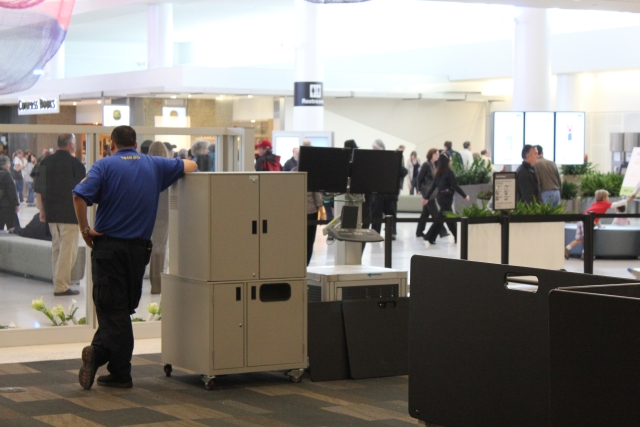
Most people who travel often know ofTSA PreCheckand Global Entry. Both programs are heavily advertised at airports and in-flight and even many credit cards provide reimbursement for these programs.Clear, a private company is also trying to make a comeback nationwide. Yet, there is also another program which is free, but it is only going to make a select few travelers’ lives easier. This program provides a Redress Control Number to flyers. It is a program through the Department of Homeland Security (DHS) and depending on your travel habits and headaches, you may want to consider applying for a Redress Number.
What Is a Redress Number?
A redress number is not the same as TSA PreCheck or Global Entry. Even if you apply for a Redress Number you are not guaranteed PreCheck or expedited screening while flying into the United States. The redress number is just another traveler number which can be saved in the air traveler’s profiles and placed on each plane ticket to reduce misidentification. Individuals with a Redress Number are more likely to receive standard screening instead of additional screening, such as thehorrid SSSS experience. Frequent flyers who do not have problems while traveling should not need to apply for a Redress Number. If you want pre-clearance and PreCheck, apply forGlobal Entry.
How to Apply for a Redress Number
A Redress Number can only be applied for directly through the Department of Homeland Security online attrip.dhs.gov. The process is very easy and requires filling out a simple3-page form. On the form, you select why you think you need a redress number and explain to DHS the issues you have had while traveling. After completing the form online, and providing a lot of personal information, you must print and sign the form and either mail it or email it to TRIP@dhs.gov. Be sure to include a copy of your passport or photo ID when submitting the application. You can also print the application, fill it out with a pen, and then scan it to a computer. At time of submission you will get a redress control number. This will become your Redress number.
The current wait time for a redress number is approximately 50 days. Or at least this is what the stock email claims from DHS. However, I applied for a redress number on June 26, 2017 and my case was processed and approved on June 30th. Despite the speedy approval, my notice did not arrive until July 10th.
Do note, that once DHS has processed your application, you are assigned a Redress Number. The Redress Control Number is on the subject line of the email from DHS letting you know that they have received your application. I recommend applying the number immediately to all reservations. As your case may process faster than the 50 days quoted.
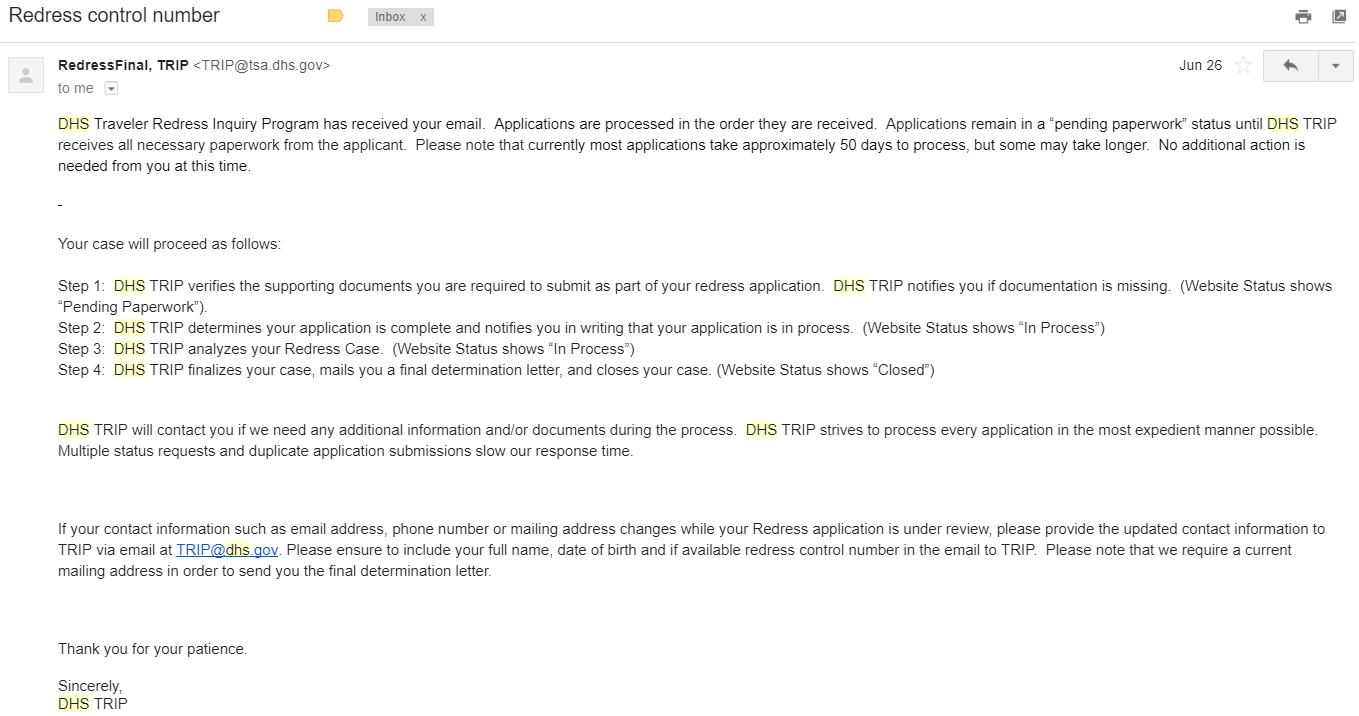
Once you are approved, a letter will come in the mail informing you that your case has been processed. The standard letter is scripted and reveals very little.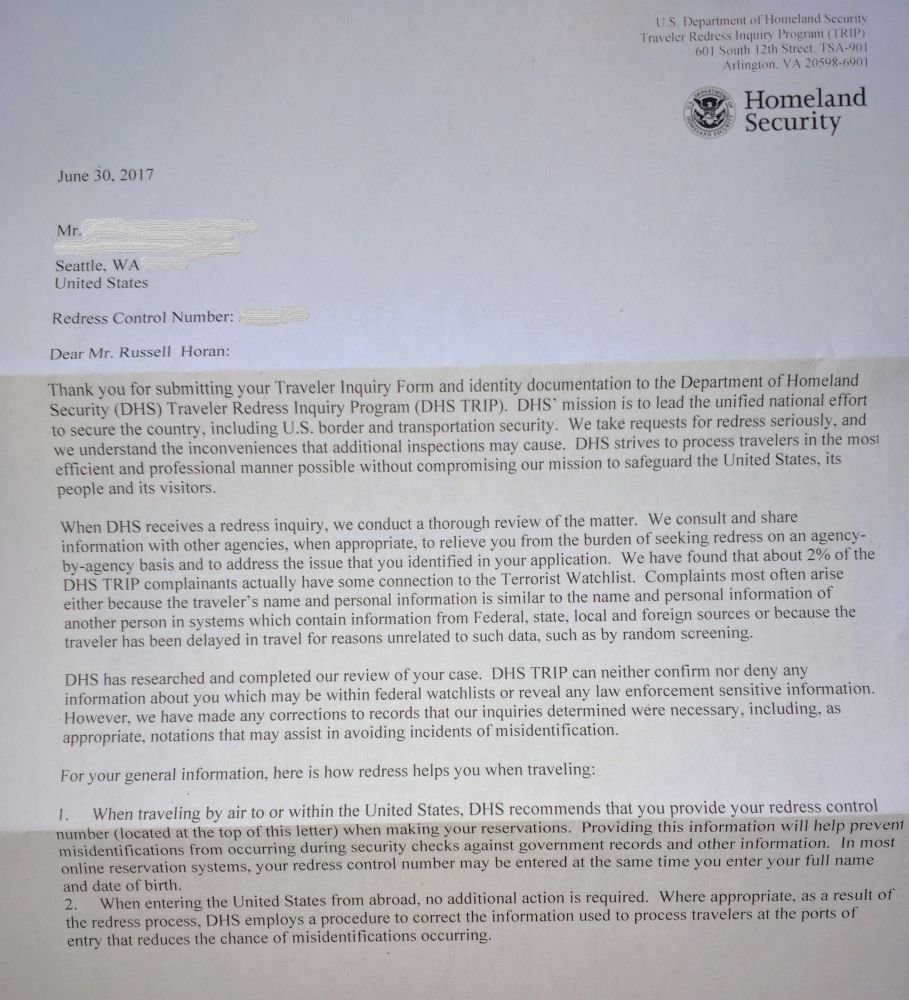
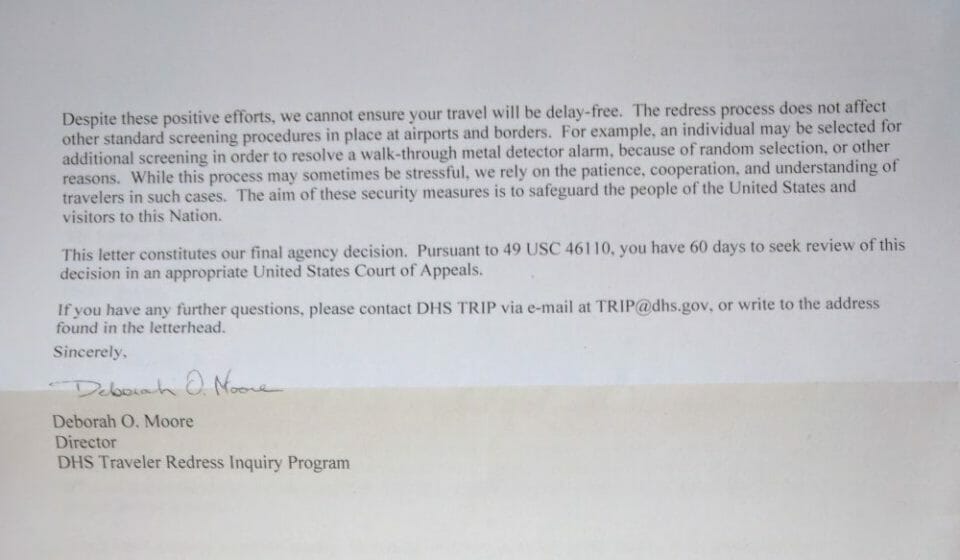
How to Use a Redress Number
A redress number is not the same as TSA PreCheck or Global Entry. Even if you apply for a Redress Number you are not guaranteed PreCheck or expedited screening while flying into the United States. The redress number is just another number which can be saved in traveler’s profiles and placed on each plane ticket to reduce misidentification. Individuals with a Redress Number are more likely to receive standard screening instead of additional screening, such as the horrid SSSS experience. Frequent flyers who do not have problems while traveling should not need to apply for a Redress Number. If you want pre-clearance and PreCheck, apply for Global Entry.
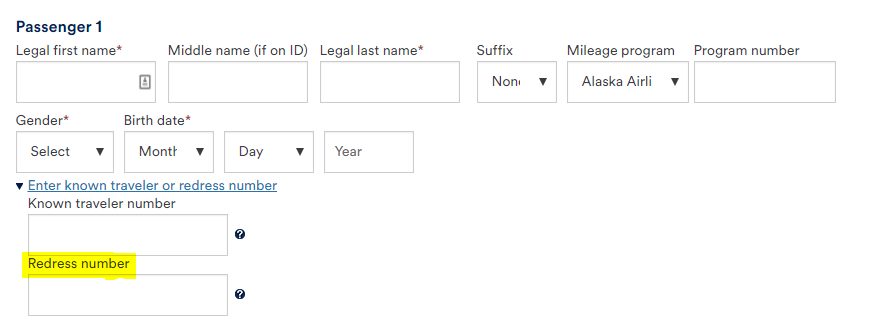
Should You Get a Redress Number?
If you are not having issues while traveling there is no reason to get a Redress Number. If you find that you constantly have trouble with either the TSA or entering the USA from abroad, a Redress Number is appropriate. Anyone can apply for a Redress Number, the program is not only for US Citizens. Even if you have PreCheck or Global Entry, a Redress my be necessary.
The most common reasons to apply for a Redress Number include:
- Always subjected to additional screening when going through an airport security checkpoint.
- Being denied boarding.
- Inability to print a boarding pass at the airport kiosk or at home.
- Must check in at a ticket counter each time you fly.
- An airline agent saying that you are on a Federal Government Watch List.
- Being detained during a travel experience by the TSA or U.S. Customs and Border Protection (CBP).
- Being repeatedly referred for secondary screening when clearing CBP.
- Being refused entry into the United States.
- CBP reports that your fingerprints were incorrect or of poor quality.
There are several other reasons one can apply for a Redress Number. The above list is only a few of the common reasons why people request a Redress Number. If you have difficulties traveling, consider a Redress Number, but also consider Global Entry. Since travel though through Istanbul, and having security issues ever since, I now have both. Every Frequent Flyer profile has my Known Traveler ID Number (Global Entry) and my Redress Number saved. This allows all agencies to communicate and hopefully reduces the risk of extra security screening after visiting “suspicious” places. Currently most passengers who visit Turkey and/or Egypt are subjected to weeks of extensive SSSS security screenings. Even long time travelers with Global Entry and PreCheck.
Final Thoughts
I can say, I never thought I would need a Redress Number, but having one has been a godsend. It has been six weeks since I transited through Istanbul and traveling is back to “normal” for me. The minute I applied for a Redress Number and applied the case number to my reservations, the SSSS dropped from my boarding pass. Although I was on Holiday and did not fly between June 26 and the 30th! As a frequent flyer, I clear security 2-4 times a week, and not having PreCheck was painful. The extra time it took to check-in with an agent and having an extensive security screen due to the SSSS wasted at minimum of 2-3 hours of time each week. Getting a Redress number was the best thing that has happened to me in 2017. Only because everything seems normal again!
If you travel, even if infrequently, but find yourself constantly subjected to extra security checks, apply for a redress number. It will result in a massive time-saving and reduce your stress on your next trip.
